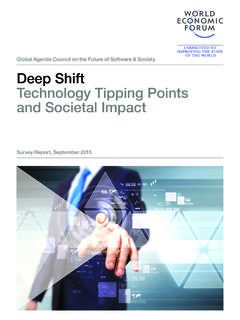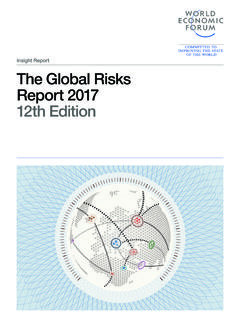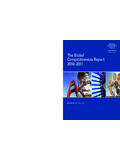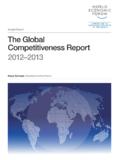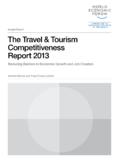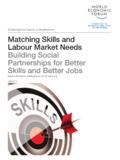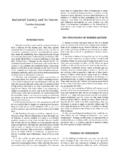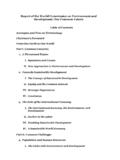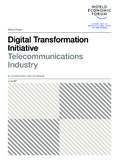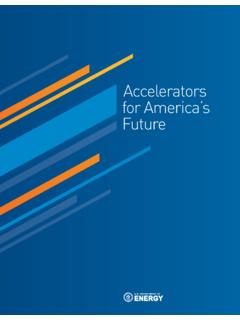Transcription of Insight Report Readiness for the Future of …
1 Insight ReportIn collaboration with KearneyReadiness for the Future of production Report 2018 Insight ReportReadiness for the Future of production Report 2018In collaboration with KearneyThe Readiness for the Future of production Report 2018 is published by the World Economic Forum s System Initiative on Shaping the Future of THE WORLD ECONOMIC FORUMC heryl MartinMember of the Managing BoardRichard SamansMember of the Managing BoardHelena LeurentHead, System Initiative on Shaping the Future of ProductionFrancisco BettiLead, System Initiative on Shaping the Future of ProductionMargareta Drzeniek-HanouzHead, System Initiative on Shaping the Future of Economic ProgressThierry GeigerHead, Research and Regional Impact, System Initiative on Shaping the Future of Economic ProgressFROM KEARNEYJ ohan AurikManaging Partner and ChairmanMauricio ZuazuaProject AdvisorOtto SchulzProject AdvisorAndrea BlaylockProject CollaboratorWe would like to thank Mike Fisher for his editing work and Neil Weinberg for graphic design and layout.
2 The online Report ( ) was created by Applied Works, Robert Gale at Design Resources Limited, and Travis Hensgen at Traversal. World Economic Forum91-93 route de la CapiteCH-1223 Cologny/GenevaSwitzerlandTel.: +41 (0)22 869 1212 Fax: +41 (0)22 786 2744E-mail: 2018 World Economic ForumAll rights part of this publication may be reproduced, stored in a retrieval system, or transmitted, in any form or by any means, electronic, mechanical, photocopying, or otherwise, without the prior permission of the World Economic Report and interactive data platform are available at 978-1-944835-16-3 TERMS OF USE AND DISCLAIMERThe Readiness for the Future of production Report 2018 presents information and data that were compiled and/or collected by the World Economic Forum.
3 Data in this Report is subject to change without notice. The terms country and nation as used in this Report do not in all cases refer to a territorial entity that is a state as understood by international law and practice. The terms cover well-defined, geographically self-contained economic areas that may not be states but for which statistical data are maintained on a separate and independent basis. Although the World Economic Forum takes every reasonable step to ensure that the data thus compiled and/or collected is accurately reflected in this Report , the World Economic Forum, its agents, officers and employees: (i) provide the data as is, as available and without warranty of any kind, either express or implied, including, without limitation, warranties of merchantability, fitness for a particular purpose and non-infringement; (ii) make no representations, express or implied, as to the accuracy of the data contained in this Report or its suitability for any particular purpose.
4 (iii) accept no liability for any use of the said data or reliance placed on it, in particular, for any interpretation, decisions, or actions based on the data in this Report . Other parties may have ownership interests in some of the data contained in this Report . The World Economic Forum in no way represents or warrants that it owns or controls all rights in all data, and the World Economic Forum will not be liable to users for any claims brought against users by third parties in connection with their use of any data. The World Economic Forum, its agents, officers, and employees do not endorse or in any respect warrant any third-party products or services by virtue of any data, material, or content referred to or included in this Report .
5 Users shall not infringe upon the integrity of the data and in particular shall refrain from any act of alteration of the data that intentionally affects its nature or accuracy. If the data is materially transformed by the user, this must be stated explicitly along with the required source citation. For data compiled by parties other than the World Economic Forum, as specified in the Technical Notes and Sources section of this Report , users must refer to these parties terms of use, in particular concerning the attribution, distribution, and reproduction of the data. When data for which the World Economic Forum is the source, as specified in the Technical Notes and Sources section of this Report , is distributed or reproduced, it must appear accurately and be attributed to the World Economic Forum.
6 This source attribution requirement is attached to any use of data, whether obtained directly from the World Economic Forum or from a user. Users who make World Economic Forum data available to other users through any type of distribution or download environment agree to make reasonable efforts to communicate and promote compliance by their end users with these who intend to sell World Economic Forum data as part of a database or as a standalone product must first obtain the permission from the World Economic Forum v Preface vii Executive Summary 1 Chapter 1: Preparing for the Future of production 5 Chapter 2: Measuring Readiness for the Future of production Definition of Readiness Methodology and Framework Measurement Challenges 11 Chapter 3.
7 Readiness for the Future of production Assessment Results Global Results Overview Archetype Analysis and Select Country Highlights 21 Chapter 4: Drivers of production Analysis Driver 1: Technology & Innovation Driver 2: Human Capital Driver 3: Global Trade & Investment Driver 4: Institutional Framework Driver 5: Sustainable production Driver 6: Demand Environment 27 Way Forward 29 Endnotes 31 Acknowledgements 33 Appendix A: Regional and Income Group Classifications 35 Appendix B: Detailed Results by Archetype 43 Appendix C: Technical Notes and Sources 51 How to Read the Country Profiles 53 List of Countries 54 Country ProfilesReadiness for the Future of production Report 2018 iiiPrefaceAs the Fourth Industrial Revolution gathers momentum, decision-makers from the public and private sectors are confronted with a new set of uncertainties regarding the Future of production .
8 Technologies are transcending the computing capabilities associated with the digital revolution, transforming the physical world through robotics and new methods of production ; enhancing human beings physically, mentally, and experientially; and permeating the environment to facilitate greater interconnectivity, monitoring, and efficiency of resource use. Rapidly emerging technologies such as the Internet of Things, artificial intelligence, wearables, robotics and additive manufacturing are spurring the development of new production techniques and business models that will fundamentally transform global production . These technologies are also driving new, more distributed and connected value chains. Both the speed and scope of change add a layer of complexity to the already challenging task of developing and implementing industrial strategies that promote productivity and inclusive a dynamic and changing world, the World Economic Forum System Initiative on the Future of production seeks to help usher in a sustainable production Future that is: Solution-driven: technology can tackle and solve challenges that have previously been insurmountable.
9 Human-centric: technology can unlock human potential by unleashing creativity, innovation and productivity in new ways. Sustainable: technology can promote sound production processes that minimize negative environmental impact, conserve energy and resources and enable carbon neutrality. Inclusive: employees, companies and countries at different stages of development benefit from Fourth Industrial Revolution technologies and the transformation of production the framework of the System Initiative, the Country Readiness for the Future of production project focuses primarily on the fourth objective: inclusive transformation and growth. As production systems stand on the brink of another technological revolution, countries need to build awareness of the changing nature of production , determine how to best prepare to benefit from this transformation and collaborate across the public and private sector to enhance Readiness .
10 This project builds upon the World Economic Forum s competitiveness and benchmarking expertise and is a result of collaboration between the Future of production and Future of Economic Progress teams at the World Economic Forum, in collaboration with Kearney, has developed a new benchmarking framework, diagnostic tool and data set to help countries understand their current level of Readiness for the Future of production , as well as corresponding opportunities and challenges. This Report shares the results from the inaugural Readiness for the Future of production Assessment and insights from in-depth multistakeholder analysis in select countries, including India, Japan, Mexico, Russian Federation and South Africa. Findings are intended to catalyse multistakeholder dialogue to inform the development of modern industrial strategies.

